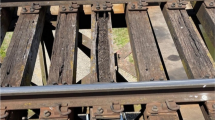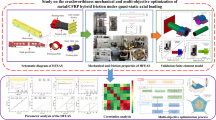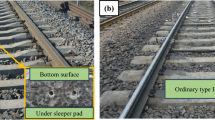Abstract
For the tower crane, the luffing trolley and cargoes are equivalent to concentrated force. This study established a moving load model. The transient dynamic analysis method was used to carry out dynamic simulation, analyze and obtain the vibration characteristics of the boom under luffing and lifting, and calculate the fatigue life of the key components of the boom based on the S-N curve. The analysis results showed that the greater the luffing speed, the greater the arm end vibration amplitude. The lifting speed has influence on the amplitude and frequency of vibration. Under the worst working conditions, the minimum service life of the top chord 638 of the most dangerous component was 17.96 years, which can meet the requirements of the safety regulations for tower cranes. At the same time, the damage degree of the dangerous component during luffing was greater than that during lifting.
Similar content being viewed by others
References
W. Chen, X. R. Qin and Z. G. Yang, Wind load characteristics analysis of mast and jib of tower crane, Journal of Zhejiang University (Engineering Science), 52 (12) (2018) 2262–2270.
K. Fu, L. F. Yu, B. Cheng and Y. M. Wu, Wind-induced response analysis of a tower crane, Modern Manufacturing Engineering (7) (2017) 138–142.
J. Ma, Z. T. Wang, D. Zhou, L. H. Liao and Z. Huang, Analysis of wind-induced vibration and fatigue effects of a typical tower crane, Journal of Shanghai Jiaotong University, 48 (6) (2014) 804–808.
C. Klinger, Failures of cranes due to wind induced vibrations, Engineering Failure Analysis, 43 (2014) 198–220.
X. S. Li, and G. Liang, Vibration anslysis of the main girder of overhead traveling crane considering the effect of moving mass, Lifting the Transport Machinery (4) (2016) 59–63.
Y. F. Tao, X. G. Liu, N. X. Shao and K. D. Chen, Time varying reliability analysis of metal structure of tower crane, Hoisting and Conveying Machinery (9) (2015) 1–6.
J. Zhao, W. W. Zhang and H. W. Ma, Dynamic response and crack detection of simply supported beam under moving loads, Journal of Vibration and Shock, 30 (6) (2011) 97–103.
M. X. Dong, E. Zhang, L. W. Liang, S. J. Han and C. N. Yang, Influence of translation motion and payload on jib vibration of tower cranes, Chinese Journal of Construction Machinery, 16 (4) (2018) 347–351.
Z. Chen, H. G. Wang and J. H. Wang, Dynamic response analysis of trolley traveling on the front girder of ship unloader based on ANSYS, Hoisting and Conveying Machinery (5) (2015) 63–67.
G. Q. Wei, K. Hu and Z. Yu, Simulation of fatigue life field of crane girder considering moving load, Hoisting and Conveying Machinery (9) (2021) 47–53.
H. Q. Jiang and S. C. Li, The wind-induced vibration response for tower crane based on virtual excitation method, The Open Mechanical Engineering Journal (8) (2014) 201–205.
B. J. Dong and F. R. Zhao, Research on calculation of vehicle fatigue damage based on stress of rain flow model, Machine Building and Automation, 51 (4) (2021) 75–77.
Q. L. Zhang, J. Liu and B. Hong, Fatigue damage analysis of steel truss members of baiyang changjiang river highway bridge under random vehicle volume, World Bridges, 50 (5) (2022) 87–93.
H. Xiao, G. X. Li and Y. J. Zhou, Structure fatigue damage analysis and fatigue life prediction of launch pad for a launch vehicle, Journal of Ordnance Equipment Engineering, 45 (7) (2022) 209–216.
S. Jun and J. B. Park, Development of empirical formulas for approxi-mate spectral moment based on rain-flow counting stress-range distribution, Journal of Ocean Engineering and Technology, 35 (4) (2021) 257–265.
W. W. Zhao, C. Y. Bai, X. Y. Cao, C. H. Mi, B. Zhang and Y. Zhou, Analysis of fatigue life for tower crane in service, Construction Machinery (1) (2013) 72–74.
GB50017-2017, Standard for Design of Steel Structures, National Standard of the People’s Republic of China (2017).
Acknowledgments
This project is supported by the jiangsu normal university doctoral degree teacher research support project (Grant no.17 XLR047).
Author information
Authors and Affiliations
Corresponding author
Additional information
Hongqi Jiang is an Associate Professor at the School of Mechanical and Electrical Engineering, Jiangsu Normal University, and holds a doctoral degree in engineering mechanics from China University of Mining and Technology. He mainly engaged in teaching and research on computational mechanics and modern design methods, with research interests including engineering structural strength and structural dynamics.
Xiao Jiang is an assistant engineer of management engineering of China Coal Industry Association, and received Master of Science degree of China University of Mining and Technology. His research interests include engineering management and statistics.
Rights and permissions
About this article
Cite this article
Jiang, H., Jiang, X. Fatigue life prediction for tower cranes under moving load. J Mech Sci Technol 37, 6461–6466 (2023). https://doi.org/10.1007/s12206-023-1118-x
Received:
Revised:
Accepted:
Published:
Issue Date:
DOI: https://doi.org/10.1007/s12206-023-1118-x




